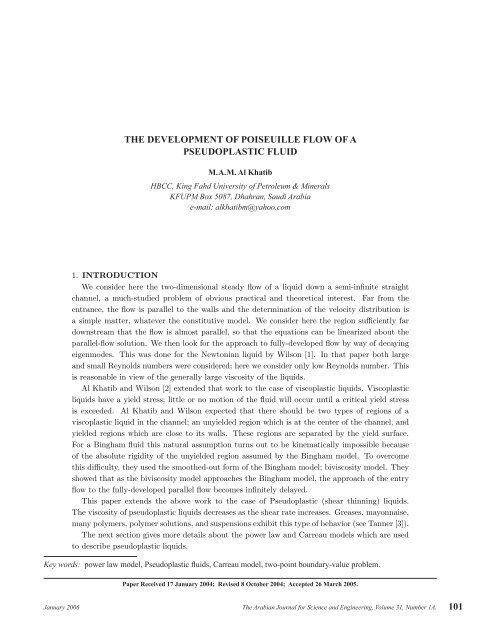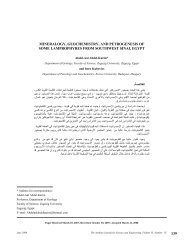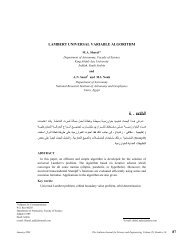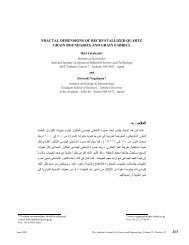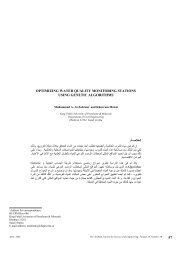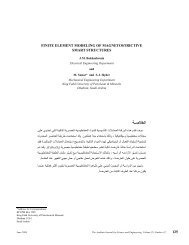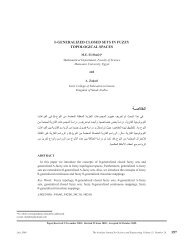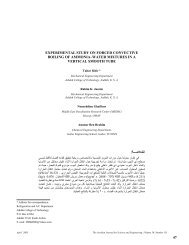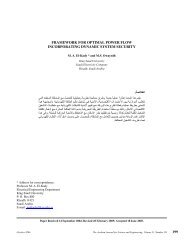the development of poiseuille flow of a pseudoplastic fluid
the development of poiseuille flow of a pseudoplastic fluid
the development of poiseuille flow of a pseudoplastic fluid
You also want an ePaper? Increase the reach of your titles
YUMPU automatically turns print PDFs into web optimized ePapers that Google loves.
THE DEVELOPMENT OF POISEUILLE FLOW OF A<br />
PSEUDOPLASTIC FLUID<br />
M.A.M. Al Khatib<br />
HBCC, King Fahd University <strong>of</strong> Petroleum & Minerals<br />
KFUPM Box 5087, Dhahran, Saudi Arabia<br />
e-mail: alkhatibm@yahoo.com<br />
M.A.M. Al Khatib<br />
1. INTRODUCTION<br />
We consider here <strong>the</strong> two-dimensional steady <strong>flow</strong> <strong>of</strong> a liquid down a semi-infinite straight<br />
channel, a much-studied problem <strong>of</strong> obvious practical and <strong>the</strong>oretical interest. Far from <strong>the</strong><br />
entrance, <strong>the</strong> <strong>flow</strong> is parallel to <strong>the</strong> walls and <strong>the</strong> determination <strong>of</strong> <strong>the</strong> velocity distribution is<br />
a simple matter, whatever <strong>the</strong> constitutive model. We consider here <strong>the</strong> region sufficiently far<br />
downstream that <strong>the</strong> <strong>flow</strong> is almost parallel, so that <strong>the</strong> equations can be linearized about <strong>the</strong><br />
parallel-<strong>flow</strong> solution. We <strong>the</strong>n look for <strong>the</strong> approach to fully-developed <strong>flow</strong> by way <strong>of</strong> decaying<br />
eigenmodes. This was done for <strong>the</strong> Newtonian liquid by Wilson [1]. In that paper both large<br />
and small Reynolds numbers were considered; here we consider only low Reynolds number. This<br />
is reasonable in view <strong>of</strong> <strong>the</strong> generally large viscosity <strong>of</strong> <strong>the</strong> liquids.<br />
Al Khatib and Wilson [2] extended that work to <strong>the</strong> case <strong>of</strong> viscoplastic liquids. Viscoplastic<br />
liquids have a yield stress; little or no motion <strong>of</strong> <strong>the</strong> <strong>fluid</strong> will occur until a critical yield stress<br />
is exceeded. Al Khatib and Wilson expected that <strong>the</strong>re should be two types <strong>of</strong> regions <strong>of</strong> a<br />
viscoplastic liquid in <strong>the</strong> channel; an unyielded region which is at <strong>the</strong> center <strong>of</strong> <strong>the</strong> channel, and<br />
yielded regions which are close to its walls. These regions are separated by <strong>the</strong> yield surface.<br />
For a Bingham <strong>fluid</strong> this natural assumption turns out to be kinematically impossible because<br />
<strong>of</strong> <strong>the</strong> absolute rigidity <strong>of</strong> <strong>the</strong> unyielded region assumed by <strong>the</strong> Bingham model. To overcome<br />
this difficulty, <strong>the</strong>y used <strong>the</strong> smoo<strong>the</strong>d-out form <strong>of</strong> <strong>the</strong> Bingham model; biviscosity model. They<br />
showed that as <strong>the</strong> biviscosity model approaches <strong>the</strong> Bingham model, <strong>the</strong> approach <strong>of</strong> <strong>the</strong> entry<br />
<strong>flow</strong> to <strong>the</strong> fully-developed parallel <strong>flow</strong> becomes infinitely delayed.<br />
This paper extends <strong>the</strong> above work to <strong>the</strong> case <strong>of</strong> Pseudoplastic (shear thinning) liquids.<br />
The viscosity <strong>of</strong> <strong>pseudoplastic</strong> liquids decreases as <strong>the</strong> shear rate increases. Greases, mayonnaise,<br />
many polymers, polymer solutions, and suspensions exhibit this type <strong>of</strong> behavior (see Tanner [3]).<br />
The next section gives more details about <strong>the</strong> power law and Carreau models which are used<br />
to describe <strong>pseudoplastic</strong> liquids.<br />
Key words: power law model, Pseudoplastic <strong>fluid</strong>s, Carreau model, two-point boundary-value problem.<br />
Paper Received 17 January 2004; Revised 8 October 2004; Accepted 26 March 2005.<br />
January 2006 The Arabian Journal for Science and Engineering, Volume 31, Number 1A. 101
102<br />
M.A.M. Al Khatib<br />
2. CONSTITUTIVE MODEL<br />
The power law model, which is simple and easy to handle, is <strong>the</strong> most well-known and widely used empiricism<br />
in engineering work; many specific <strong>flow</strong> problems and heat transfer problems have been solved using it and <strong>the</strong><br />
results have proven to be useful. The constitutive equation <strong>of</strong> <strong>the</strong> power law model in simple shear <strong>flow</strong> can be<br />
written as<br />
<br />
<br />
τ = m . <br />
γ<br />
<br />
.<br />
.<br />
n−1 . γ (2.1)<br />
where γ is <strong>the</strong> shear rate, n is <strong>the</strong> index number (0
3. EQUATIONS OF MOTION<br />
M.A.M. Al Khatib<br />
We consider a region far downstream from <strong>the</strong> entrance <strong>of</strong> a straight channel <strong>of</strong> width 2h, with <strong>the</strong> origin<br />
in <strong>the</strong> centre <strong>of</strong> <strong>the</strong> channel. The velocity components <strong>of</strong> <strong>the</strong> <strong>flow</strong> in <strong>the</strong> downstream, x, and transverse, y,<br />
directions are u and v respectively.<br />
The smoo<strong>the</strong>d-out power law model which is going to be used here, <strong>the</strong> Carreau Model, is given in<br />
3-dimensional form by Equation (2.2) with · γ= 2eijeij (see Bird [4]). With η∞ = 0 for simplicity, we get<br />
where e ∗ ij<br />
τ ∗ ij =2η◦<br />
is <strong>the</strong> strain-rate tensor.<br />
<br />
1+(λ · γ) 2(n−1) /2<br />
e ∗ ij<br />
By neglecting <strong>the</strong> inertial effects, <strong>the</strong> equations <strong>of</strong> motion in <strong>the</strong> steady state in <strong>the</strong> x and y directions are<br />
given respectively by<br />
0=− ∂P∗<br />
∂x + ∂τ∗ xx<br />
∂x + ∂τ∗ xy<br />
∂y ,<br />
0=− ∂P∗<br />
∂y + ∂τ∗ xy<br />
∂x + ∂τ∗ yy<br />
∂y .<br />
First we determine <strong>the</strong> basic parallel <strong>flow</strong> which is approached far downstream. Here <strong>the</strong> pressure gradient is<br />
uniform and we put − ∂P<br />
∂x = Gr > 0 for convenience. Then from (3.2) we get<br />
0=Gr + ∂τ∗ xy<br />
∂y<br />
January 2006 The Arabian Journal for Science and Engineering, Volume 31, Number 1A. 103<br />
(3.1)<br />
(3.2)<br />
. (3.3)<br />
Integrating (3.3) with respect to y using <strong>the</strong> symmetry condition τ ∗ xy = 0 when y =0weget<br />
τ ∗ xy = −Gr y . (3.4)<br />
Using Equations (3.1) and (3.4) we get<br />
−Gr y = η◦<br />
<br />
1+(λ (u ∗ ◦) ′ ) 2 (n−1) /2<br />
where (u ∗ ◦) ′ = ∂u ∗ ◦/∂y and <strong>the</strong> subscript ◦ refers to <strong>the</strong> parallel <strong>flow</strong> solution.<br />
(u ∗ ◦) ′ . (3.5)<br />
Now we choose dimensionless variables; we put Y = y/h, X = x/h, P = P ⋆ /Gr h, τij = τ ∗ ij /Grh, and<br />
u◦ = η◦u∗ ◦/Grh2 . Then <strong>the</strong> dimensionless form <strong>of</strong> <strong>the</strong> solution is given by <strong>the</strong> following equations<br />
t◦ = −Y, (3.6)<br />
−Y =<br />
<br />
1+k 2 ( u ′<br />
◦) 2 (n−1)/2<br />
u ′<br />
◦ , (3.7)<br />
where t◦ and u ′<br />
◦ are <strong>the</strong> stress and velocity derivative in <strong>the</strong> case <strong>of</strong> parallel <strong>flow</strong> and k =(λGrh)/η◦. Note<br />
that when k is large, (3.7) represents a shear thinning <strong>fluid</strong> and when k is small, (3.7) represents a Newtonian<br />
<strong>fluid</strong>. Equation (3.7) is solved numerically with <strong>the</strong> boundary condition u◦ = 0 when Y = −1, giving u ′<br />
◦ and u◦.<br />
Examples <strong>of</strong> velocity pr<strong>of</strong>iles are given in Figures 2, 3, and 4.
104<br />
M.A.M. Al Khatib<br />
Figure 2. The velocity pr<strong>of</strong>iles <strong>of</strong> <strong>the</strong> Carreau model with k =2and for different values <strong>of</strong> n.<br />
velocity<br />
10<br />
9<br />
8<br />
7<br />
6<br />
5<br />
4<br />
3<br />
2<br />
1<br />
0<br />
0 –0.8 –0.6 –0.4 –0.2 0 0.2 0.4 0.6 0.8 1<br />
V<br />
Figure 3. The velocity pr<strong>of</strong>iles <strong>of</strong> <strong>the</strong> Carreau model with k =10and for different values <strong>of</strong> n.<br />
The Arabian Journal for Science and Engineering, Volume 31, Number 1A. January 2006<br />
n=0.3<br />
n=0.5<br />
n=0.8<br />
n=1
velocity<br />
0.6<br />
0.5<br />
0.4<br />
0.3<br />
0.2<br />
0.1<br />
0<br />
-1 -0.8 -0.6 -0.4 -0.2 0<br />
y<br />
0.2 0.4 0.6 0.8 1<br />
M.A.M. Al Khatib<br />
Figure 4. The velocity pr<strong>of</strong>iles <strong>of</strong> <strong>the</strong> Carreau model with k =0.5 and for different values <strong>of</strong> n (curves from top to bottom<br />
are, respectively, n =0.1, 0.2, 0.3, 0.5, 0.8, 1).<br />
The velocity pr<strong>of</strong>iles in Figures 2 and 3 correspond to <strong>the</strong> case k>1. They indicate that <strong>the</strong> velocity gradients<br />
near <strong>the</strong> boundaries diverge as <strong>the</strong> index n tends to 0. In fact, it is easy to prove from Equation (3.7) for k>1<br />
and small n that<br />
|u ′ ◦(±1)| = k 1/n−1 .<br />
On <strong>the</strong> o<strong>the</strong>r hand, this divergence does not exist if k
106<br />
M.A.M. Al Khatib<br />
The constitutive Equation (3.1) becomes, in dimensionless form,<br />
After linearization we find<br />
<br />
τij =2 1+k 2 · γ 2 (n−1) /2<br />
eij. (3.10)<br />
∂u1<br />
τ1 XX =2θ◦<br />
∂X<br />
∂v1<br />
τ1YY =2θ◦<br />
∂Y<br />
τ1 XY = µ◦<br />
∂u1<br />
∂Y<br />
<br />
∂v1<br />
+<br />
∂X<br />
where θ◦ =(1+k 2 u ′ 2<br />
◦ ) (n−1)/2 and µ◦ = θ◦<br />
1+nk 2 u ′ 2<br />
◦<br />
1+k 2 u ′ 2<br />
◦<br />
.<br />
(3.11)<br />
From (3.9) and (3.11) with u1 =ΨY and v1 = −ΨX, where Ψ is <strong>the</strong> stream function, we have<br />
∂2 ∂X∂Y (4θ◦ΨXY<br />
2 ∂ ∂2<br />
)+ −<br />
∂Y 2 ∂X2 <br />
[µ◦(ΨYY − ΨXX)] = 0 (3.12)<br />
and <strong>the</strong> boundary conditions on <strong>the</strong> walls Y = ±1 are<br />
Now let<br />
Ψ(X, ±1) = 0, ΨY (X, ±1) = 0. (3.13)<br />
Ψ=Φ(Y ) exp(−αX) (3.14)<br />
as in Wilson [1]. Substituting (3.14) in (3.12) we get<br />
<br />
2 d<br />
4α<br />
dY<br />
with boundary conditions<br />
θ◦<br />
2<br />
2 dΦ d d Φ<br />
+ − α2 µ◦<br />
dY dY 2 dY 2 − α2 <br />
Φ = 0 (3.15)<br />
Φ(±1) = Φ ′ (±1) = 0 (3.16)<br />
and this determines <strong>the</strong> eigenvalues α. These are complex in general and we are interested in <strong>the</strong> decaying modes<br />
for which Re(α) > 0. Note that when k =0,orn =1weget<br />
θ◦ = µ◦ =1,<br />
and we recover <strong>the</strong> Newtonian case<br />
Φ iv +2α 2 Φ ′′<br />
+ α 4 Φ = 0 (3.17)<br />
studied by Wilson [1]. The eigenvalues satisfy sin 2α = ±2α, with four families <strong>of</strong> roots, one in each quadrant<br />
<strong>of</strong> <strong>the</strong> complex plane. The two signs in sin 2α = ±2α correspond to odd and even solutions to Equation (3.15),<br />
The Arabian Journal for Science and Engineering, Volume 31, Number 1A. January 2006
M.A.M. Al Khatib<br />
respectively. Examples <strong>of</strong> <strong>the</strong> eigenvalues for <strong>the</strong> Newtonian case are given in Table 1. These eigenvalues are <strong>the</strong><br />
same obtained by Wilson [1].<br />
Note that if we work out <strong>the</strong> same <strong>the</strong>ory for <strong>the</strong> power law model, <strong>the</strong>n θ◦ and µ◦ are given by<br />
θ◦ = k 1−1/n |y| 1−1/n and µ◦ = nθ◦,<br />
and <strong>the</strong> equation corresponding to (3.15) is given by<br />
Φ iv +(4r − 2)α 2 Φ ′′<br />
+ α 4 Φ+ 2<br />
<br />
(1 − r) Φ<br />
Y ′′′<br />
+(2r− 1)α 2 Φ ′<br />
+ r<br />
(r − 1)(Φ′′ − α<br />
Y 2 2 Φ) = 0 (3.18)<br />
where r =1/n. The scaling used here is Y = y/h, X = x/h, andu◦ = uQ/h where Q is <strong>the</strong> <strong>flow</strong> rate. By using<br />
<strong>the</strong> power series method with Φ = Y σ amY m <strong>the</strong> solution <strong>of</strong> <strong>the</strong> above equation will be given by<br />
Φ ≈ A + BY + CY r+1 + DY r+2<br />
where A, B, C, and D are constant, and σ =0, 1, r+1, and r + 2 are <strong>the</strong> four roots <strong>of</strong> <strong>the</strong> indicial equation<br />
associated with Equation (3.18). Since r is not an integer, in general, <strong>the</strong> third and fourth terms are weakly<br />
singular, as noted. And in order to satisfy <strong>the</strong> boundary conditions at <strong>the</strong> center line <strong>of</strong> <strong>the</strong> channel, that <strong>the</strong><br />
solution is odd or even, requires that ei<strong>the</strong>r A and C or B and D are zero respectively. But it would be very<br />
difficult to distinguish numerically between Y r+1 and Y r+2 because <strong>the</strong>y are generally high powers.<br />
4. RESULTS AND DISCUSSION<br />
Table 1. The Values <strong>of</strong> α for <strong>the</strong> Newtonian Case.<br />
Eigenvalue α<br />
1 2.106196 + i1.125364<br />
2 3.748838 + i1.384339<br />
3 5.356269 + i1.551574<br />
4 6.949978 + i1.671049<br />
5 8.536682 + i1.775544<br />
6 10.119259 + i1.85838<br />
The problem <strong>of</strong> this paper has been reduced to a linear two-point boundary-value problem for a fourthorder<br />
differential equation which is linearized on <strong>the</strong> assumption <strong>of</strong> small disturbance from <strong>the</strong> fully-developed<br />
parallel <strong>flow</strong>, leading to <strong>the</strong> eigenvalue equation given in (3.15). Several numerical methods have previously<br />
been used to solve eigenvalue equations. For example, Bramley and Dennis [5] calculated <strong>the</strong> eigenvalues for<br />
<strong>the</strong> stationary perturbation <strong>of</strong> Poiseuille <strong>flow</strong> (Newtonian case) by expanding Φ and its derivatives in terms <strong>of</strong><br />
Chebyshev polynomials. In fact, <strong>the</strong> same method is used by Orszag [6] to get an accurate solution <strong>of</strong> <strong>the</strong> Orr–<br />
Sommerfeld stability equation. Stocker and Duck [7] have also used <strong>the</strong> method to investigate <strong>the</strong> eigenvalues for<br />
<strong>the</strong> stationary perturbation <strong>of</strong> Couette–Poiseuille <strong>flow</strong>. While this method has proven to be accurate we adopt<br />
a more straightforward and suitable one for our equations which are more complex than those investigated by<br />
<strong>the</strong> previously mentioned authors.<br />
Equation (3.15) is solved numerically using <strong>the</strong> NAG routines D02CAF (Adams method) and C02NBF (Powell<br />
hybrid method) with <strong>the</strong> boundary conditions in (3.16), giving <strong>the</strong> eigenvalues α for different values <strong>of</strong> k.<br />
January 2006 The Arabian Journal for Science and Engineering, Volume 31, Number 1A. 107
108<br />
M.A.M. Al Khatib<br />
Examples <strong>of</strong> <strong>the</strong> eigenvalues are given in Tables 2, 3, and 4 for <strong>the</strong> same values <strong>of</strong> k used to draw <strong>the</strong> velocity<br />
pr<strong>of</strong>iles in Figures 2, 3, and 4.<br />
Table 2. The Leading Eigenvalue α for <strong>the</strong> Case k =2and n → 0.<br />
n α<br />
1.000 2.106196 + i1.125364<br />
0.900 2.063433 + i1.116431<br />
0.800 2.014212 + i1.106579<br />
0.700 1.956469 + i1.095871<br />
0.600 1.886985 + i1.084694<br />
0.500 1.800307 + i1.074300<br />
0.400 1.685923 + i1.068200<br />
0.300 1.519094 + i1.074583<br />
0.200 1.225893 + i1.094100<br />
0.150 0.975289 + i1.068689<br />
0.100 0.626237 + i 0.902539<br />
0.050 0.218521 + i 0.380135<br />
0.040 0.132731 + i 0.230975<br />
0.030 0.059276 + i 0.109136<br />
0.025 0.022121 + i 0.048524<br />
0.024 0.014812 + i 0.036458<br />
0.023 0.007509 + i 0.025245<br />
0.022 0.000353 + i 0.014025<br />
Table 3. The Leading Eigenvalue α for <strong>the</strong> Case k =10and n → 0.<br />
n α<br />
1.00 2.106196 + i1.125364<br />
0.90 2.035593 + i1.128023<br />
0.80 1.955879 + i1.135971<br />
0.70 1.863159 + i1.152236<br />
0.60 1.748825 + i1.180960<br />
0.50 1.592574 + i1.223862<br />
0.40 1.353831 + i1.260822<br />
0.30 0.992884 + i1.205290<br />
0.20 0.544458 + i 0.881442<br />
0.15 0.309815 + i 0.565653<br />
0.12 0.155244 + i 0.392127<br />
0.11 0.105398 + i 0.332444<br />
0.10 0.054936 + i 0.272450<br />
0.09 0.004784 + i 0.218245<br />
The Arabian Journal for Science and Engineering, Volume 31, Number 1A. January 2006
Table 4. The Leading Eigenvalue α for <strong>the</strong> Case k =0.5 and n → 0.<br />
n α<br />
1.00 2.106196 + i1.125364<br />
0.90 2.098909 + i1.122195<br />
0.80 2.091326 + i1.118841<br />
0.70 2.083419 + i1.115280<br />
0.60 2.075158 + i1.111489<br />
0.50 2.066506 + i1.107441<br />
0.40 2.057417 + i1.103102<br />
0.30 2.048824 + i1.098916<br />
0.20 2.037720 + i1.093385<br />
0.10 2.026973 + i1.087899<br />
0.00 2.015508 + i1.081899<br />
M.A.M. Al Khatib<br />
From Tables 2, 3, and 4 and <strong>the</strong> corresponding graph given in Figure 5, it appears that when k = 2 and<br />
k = 10, Re(α) → 0 as <strong>the</strong> power law index, n → 0.0220 and 0.0892 respectively. This implies that, when k =2<br />
and k = 10, <strong>the</strong> parallel <strong>flow</strong> is unstable for 0
110<br />
M.A.M. Al Khatib<br />
From <strong>the</strong> above results and <strong>the</strong> velocity pr<strong>of</strong>iles in Figures 2, 3, and 4, we conclude that when k>1, Re(α)<br />
goes to a non-zero value as n → 0. On <strong>the</strong> o<strong>the</strong>r hand, when k>1, Re(α) → 0asn → nmin > 0, which implies<br />
that <strong>the</strong> parallel <strong>flow</strong> is unstable for 0


